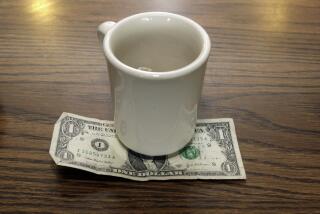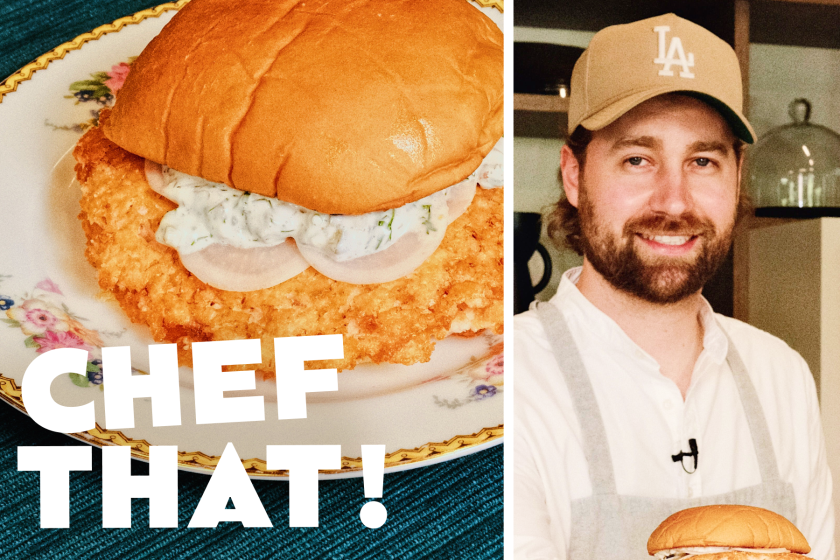Do ticked-off waiters get even by spitting on your food? What does it <i> really</i> take to get your kid in private school? From hairdressers to security guards, insiders tell us some of their . . . : Tricks of the Trade
T he transactions of daily life can be tough even when you know the score. But everyone’s had the sneaking suspicion that, somewhere along the way, things are not what they seem: the club bouncer who lets everyone in but you, the bartender who says it’s a gin and tonic, but you taste very little gin.
Times staff writers conducted an informal survey of people who make their living serving others. While most say their colleagues are on the straight and narrow, they still see enough to dish some dirty little secrets.
*
What’s your worst fear about dining out?
Cleanliness, right? You’re worried that the food or the kitchen or the chef and servers may not be as immaculate as you--and the Board of Health--would like.
Do you also worry that if you’re not charming enough, the person who serves you may do something unspeakably nasty to your food--something even Howard Stern would hesitate to verbalize?
Relax. An informal canvass of local waiters and waitresses reveals that they would rather be sauteed in sizzling oil than commit an indiscretion with a patron’s food.
“Oh, sure, I’ve seen the occasional cockroach and heard terrible tales of what happens to food in other restaurants,” says a graduate student who has waited tables for the last three years. “But I’ve seen nothing bad anywhere I’ve worked; I would have reported the person immediately. And I’d quit the job if appropriate action wasn’t taken.”
Margo, who’s worked in what she calls “casual dining places” in Los Angeles since her high school graduation 10 years ago, says she’s heard all the nasty restaurant rumors too.
“But the worst I’ve personally seen is when a server eats some food from the plate before bringing it out to the customer.
“Once or twice I’ve worked in places where, if a chicken finger or a burger dropped on the floor, they’d pick it up, throw it in the fire for a few seconds, and put it back on the customer’s plate.
“And yeah, it’s true that if a customer is especially obnoxious and the server is very immature, you may occasionally get a case where something nasty happens--like spitting on the food.” But that doesn’t happen often, she says, because restaurant workers, by and large, take a great deal of pride in their jobs and don’t vent their frustrations on the food.
“The most gross thing I see, and it’s pretty frequent, is that the girls use the restroom and do not wash their hands.” (Margo says dishonesty and tampering are more often directed at management than at the customer: “One scam in busy places is to pocket the cash from the table and claim the customer ducked out without paying.”)
Marco, 36, a waiter in a Beverly Hills eatery for the last five years, says: “When food goes back to the kitchen from the table, it gets immediately thrown away--even if it’s untouched by the person who ordered it and even if someone else is waiting for that exact same thing. We would never stoop so low as to serve food twice--not even carrot sticks or bread and butter.
“Let’s face it, we charge $10 for an individual pizza, which costs us about 40 cents to make. So there’s no need to scrimp and save and do dishonest things if the customer sends it back. We just throw it away.”
Adam Rock, environmental health services manager with the Los Angeles County Department of Health Services, says that although many consumers may fear their food is mishandled, his department gets relatively few complaints on that score. “The most complaints we get are about unsanitary conditions, cockroach or rodent sightings, dirty rags used to wipe the counters and poorly maintained restrooms,” he says.
Marco believes diners “should stop worrying so much and start behaving better to their servers and chefs.
“What really bugs us,” he explains, “is people who claim to be allergic and really aren’t. We recently had a client who said that from her appetizer to her pasta to her entire meal, she must have no dairy products. . . . It drove the chef mad--but he prepared what she wanted in a very special way. After all that, I ask what she wants for dessert and she says tiramisu (lady fingers). I say, ‘You can’t eat that. It’s totally dairy products.’ She looks at me and says, ‘That’s all right; I’m going to splurge.’ ”
Marco, only half-laughing, says both he and the chef “wanted to kill her. But even in a case like that, we would not consider doing it through the food.”
In the Mix: Good Stuff, Cheap Stuff, No Stuff
Skoal! Salud! And don’t take your eyes off the bartender.
Especially if you’re swigging mixed drinks, such as Scotch and soda.
One of the best ways for pub owners to cut costs, says our bar-tending informer, is to top mix the drinks: “First put the soda in the glass; then, pour a less-than-usual amount of whiskey on top. Serve the drink without a mixing stick.”
When the customer takes the first sip, he or she tastes off the top and thinks you’ve served a good, strong drink. Actually, you’ve top mixed , which means you’ve swindled the drinker and saved the pub owner some money.”
Another source, who’s tended many a bar in this town, says that “some dishonest bar owners fill their premium-label liquor bottles with cheap stuff. Or they’ll pour half a bottle of cheap liquor into half a bottle of good stuff.” This is called hashing , our informer says, and, of course, he’s never done it himself.
(This also violates health codes, which prohibit refilling bottles.)
And then, there’s the Bloodless Mary: “Some bartenders don’t put any vodka in a Bloody Mary because it’s a strongly spiced drink and you often cannot tell whether liquor’s in it. Always order your Bloody Mary with the vodka on the side,” he advises. “The same holds true for those complicated fruit drinks, such as pina colada--or any blended drink with many fruit flavors. Always order the rum on the side.”
Customers aren’t the only ones who get cheated. In fact, bartenders would rather cheat the owner than the customer--”It’s the customer who gives us tips.” So bartenders “try to go south with the owner’s money,” our informer explains, “which means it ends up in their pockets and not in the cash register.” This is tougher to do with computerization, our source admits, but there are still ways. One of the favorites is to “Run a Contract.”
“This means you set up a deal with a regular customer who’s a big drinker. You let him drink all he wants for free, and you ring up only one drink each time. The guy regularly leaves you a fat tip, like $20 or more. It’s a lot cheaper than he would pay for the drinks--and you reap part of his savings.”
The Admissions Ticket to Those Halls of Ivy
Every year in California, close to a million parents decide to send their darlings to private schools. Unfortunately, not all of the children will be among the chosen. . . . While most children could care less, most parents are crushed. After all, they reason, is this not the most adorable, gifted and well-behaved child ever born?
Of course. But this has little, if anything, to do with whether the child gets into the school of his or her choice.
So, what’s the secret to getting your child admitted? Some schools will tell parents straight out; others won’t.
At certain schools, the secret is Money.
Admissions directors at some of the area’s most sought-after private schools often ask parents of applicants, “How will you support the school throughout the year?”
The key word here is support. Not “support” as in rooting for the school teams or joining the PTA, or even running a bake sale.
It means support, as in giving or personally bringing in large amounts of money every year your child is enrolled--and for any number of years after the child graduates. And this is support, above and beyond the $4,000 to $10,000 a year tuition to support the school.
Stuck on a waiting list? Again, support is the key. A few highly competitive schools have been known to accept large--$25,000 is not unheard of--tokens of support during the admissions process. This has the effect of moving a child off the school’s waiting list and right into the classroom.
Unfair? Maybe. But this is the free enterprise system.
“Private schools are the last unregulated industry in the state of California,” says William L. Rukeyser, spokesman for the California Department of Education. “Other than basic safety issues, the government is not involved, maintains no quality control, and certainly has no authority over anything private schools do.”
Even the Western Assn. of Schools and Colleges, which accredits many private schools in the state, has no interest in whether schools choose to link fund-raising with the admissions process.
At less pricey parochial schools, support may mean support for the church or temple associated with the school. If you are Jewish but want your child to attend a Catholic prep school, you need not convert, but you’ll probably want to join (as in make weekly contributions to) the church anyway.
And, if someone in the admissions office should “casually” mention that the headmaster enjoys collecting, say, fine Irish crystal, take a hint.
Should You Be Alarmed if Bells Are Ringing?
D ing-Ding-Ding. Ding-Ding.
Yes, you’re hearing bells. But, don’t panic. Unless, of course, you’re in a department store and about to steal something.
Sometimes those dings are a code to have you followed, spied on, and possibly, even apprehended.
A part-time security guard at a fine department store tells us when a “Mr. Levitz or a Mrs. White” is paged--code names for male or female shoplifters--it’s because “something is probably going down.”
“Everyone in that department will respond to that code,” she says.
The head of security at another store says, most loss-prevention programs are just common sense. “If you see someone coming in wearing a big, baggy Lakers jacket or if a woman walks in with a huge suitcase of a purse instead of a regular purse, then those are tip-offs.”
Ditto for a shopper who browses with a baby stroller but no baby, or a customer who enters a store with a flat stomach and exits suddenly nine months’ pregnant.
And sometimes stopping a thief is basic instinct.
“You mostly get a feeling about someone stealing,” says a former security guard.
When that feeling strikes, it’s perfectly OK for a security guard--in the role of an undercover customer or floor walker--to become a shopper’s shadow. You, as the shopper, might not even realize you are being trailed, just as you may not be aware of video cameras hidden in light fixtures tracing your every step. Or that store security--summoned to a corner, hiding behind a clothes rack--has already described you via walkie-talkie to other plainclothes guards standing by the exits.
One step out the door is all it takes to go after a thief, says Robert Meadows, a criminal-justice instructor at Glendale Junior College and author of the forthcoming “Fundamentals of Safety and Security for the Private Protection Officer.”
“The bottom line is that the security guard has to observe the taking and the carrying-away of the item,” he says. “You can’t act on a hunch. You have to see it be concealed on the person. Then you make your approach after the person leaves the store.
“Some stores have the policy that if that person runs away, you just let him or her go,” Meadows says. “Are you going to wrestle someone to the ground for $25?” That’s a call for the store to make, he adds.
The trick, says retired South Pasadena Police Chief William Reese, is to try to get the shoplifter to pay for the merchandise before he or she walks out of the store.
“Many times a person will pay for an item while trying to make off with something they’ve slipped into a pocket or under a coat. In those cases, all you need is reasonable cause to ask that person, ‘Would you also like to pay for that tape measure you have in your pocket?’ ”
Such an approach is non-threatening and embarrasses the customer to either cough up the goods or pay for them, he says.
Adds Meadows: “Nine times out of 10 that person will give up the merchandise. The trick is not to call that person a ‘thief’ or any other name.”
All the Ins and Outs of the Club Scene
Who gets in and why has always been one of the L.A. club scene’s murkier secrets. Here’s what the club owners themselves say they’re thinking behind the roped-off door:
* If four men show up at the door together, it’s a given they’re not getting inside. The group would be better off splitting up, or approaching arriving women and coming to the door with them.
* No model has ever been turned away from any club, ever.
* Does a club want Middle Easterners or not? This is the local scene’s major quandary.
“Persians are more anathema to club owners than any other race or culture,” said a woman who has worked club doors.
The overwhelming majority of club owners interviewed for this story say that Middle Eastern males come on too strongly to women. “On one hand you’ve got guys who spend $2,000 a night,” says one club-scene veteran. “On the other hand, nothing can kill a club quicker than having these guys around.”
Of course, it’s illegal to discriminate, according to the U.S. Constitution. But what clubs really fear--more than the Constitution--are the state Department of Alcoholic Beverage Control regulations that say clubs have to be open completely to the public.
* There is even some question as to whether roped-off VIP areas are legal. Technically, a club must have “a duplicate license for designated persons” that lists the names of anyone who will be using the separate area of the club. In reality, this never happens.
* This is the all-time favorite for crowd control: Telling would-be patrons they need a jacket, a tie, an Armani suit, a Bozo the Clown mask--anything they’re not wearing. It’s even legal to some extent. According to David Wainstein, a Department of Alcoholic Beverage Control lawyer, a posted dress code with unambiguous wording is probably OK. “The public has to be advised of what it is,” he says. “That’s the main thing.”
The doorman will say, “Sorry, it’s a private party tonight.” Or “Sorry, it’s guest list only.” This is difficult to argue with. The simplest way to get listed is to make dinner reservations in the club’s restaurant. A more creative technique is to speak with the club’s banquet department about hosting a large party, then mention you’d like to look the place over, then stay.
* Another way to turn people away is to ask for more than one piece of photo identification. “Who goes around with more than one piece of picture ID?” asked one woman.
* One reason for door policies is that clubs strive to keep a male/female balance. The ideal mix is 60% women, 40% men. “When men go to a club, they want to see women,” said one owner. “And it’s the men who spend the money.” One woman who’s been to every club in town said club owners “are dreaming” if they think they can maintain a 60/40 ratio. “I don’t know anyplace that has that,” she said, “except lesbian bars.”
* “The big thing now is, everyone is a prince,” says one club co-owner. “It’s driving me nuts. They say they’re the prince of this or that country. I had one guy who said he was the prince of Spain and he didn’t even speak Spanish that well.”
* When you buy your ticket at the entrance, the window is situated so you can’t see into the club. That way if it’s empty, you won’t have second thoughts about forking out the cash. With clubs, you don’t see what you get.
* In Los Angeles, fire investigators charged with making sure clubs are up to code are both all-powerful and unbribable--a fearsome combination. “He’s the biggest hammer in town,” says an owner. “He can close you faster than anyone.”
One owner says that when he sees the marshal he immediately has the DJ put on the best dance music he’s got. This pulls patrons away from the exits and “it’s harder to count people on a dance floor.”
* “If things are getting a bit slow at the bar,” said one owner, “I have the DJ play some bad rock ‘n’ roll. You can watch them stop dancing and say, ‘I think I’ll go have a drink.’ Then a couple songs later, you go back to the good stuff.”
Tips Can Stave Off a Bad Hairdresser Day
Like your hair? Then learn to like your hairdresser.
Stylists who feel liked, even if they are not, agree they may treat their clients better. (That means: Don’t be late. Don’t complain. Don’t forget the tip, or the birthday present, or the holiday gift.)
If they don’t feel liked or don’t like you, pssssssst, here’s what you can expect from some:
* Is your haircut too short or awfully uneven?
Certain savvy stylists will keep cutting until the problem--and possibly, the hair--is all gone. An experienced hairdresser will easily convince you that a) “Short is in;” b) “Layers are back” or c) “It’s just a new look. I know you’re going to love it!”
* Is your hair just terrible? Don’t expect miracles. But you might expect to be sold a lot of extra services and products that may or may not alter the born-in badness of your locks.
* Bald? Or on the way? Forget it. Prepare to spend hundreds of dollars and hundreds of hours trying to halt the inevitable.
But, hey, enjoy it. But not out loud. Unless you have a secret juicy enough for a supermarket tabloid (but has yet to be published anywhere ), many successful stylists do not enjoy talking or being talked to after about 4 p.m.
But don’t expect arrests from the state Board of Barbering and Cosmetology. While it hears plenty of complaints about beauty professionals, few involve bad haircuts. In those cases, the board suggests a trip back to the stylist or salon owner to give them a chance to resolve the problem.
The Soft Sell as a Driving Force
Mickey Garrett vividly remembers the couple with babe in arms, a bad case of car-buying jitters and just $100 a month to spare on a new Chevrolet.
The salesman wouldn’t budge from $104.
“For $4 they worked that poor couple over,” Garrett says. “That was the day I walked away from selling cars.”
That also was the day--in the early 1950s--when an American stereotype reigned. Car hucksters wore tartan jackets and sold nothing but cream puffs to the big guy and his missus.
“Ten years ago, the hard TOs (turnovers) still represented roughly 75% of the total sales force,” explains Garrett, now vice president of the Greater Los Angeles Motor Car Dealers Assn.. “But today, they (hard sellers) are down to about 25% and growing smaller each year.”
Dealers are now experimenting with fixed prices and softer salespersons working for salaries, not commission. Younger, better educated, sellers are graded with a Customer Satisfaction Index monitored by the manufacturer representing their franchises.
Still, whether it has to do with Hondas or two-humped camels, selling remains a knack with victory consistently going to the smoothest with the niftiest.
For Paul Filipow, 35, two years with Universal City Nissan, the skill is realizing that most customers have been victims of yesterday’s sharpies.
So he reverses the stereotype, becomes a listener, wears a tie, doesn’t smoke, has a haircut every four weeks and sees each sale as “my opportunity to prove that we’re not all like that (hard sellers) . . . and then you give them what they want, not what you want to sell them.”
Ken Marin, 40, of Longo Toyota in El Monte reads his customers--especially what they drive to the dealership.
“If they come up in a four-door Taurus this is a family man, someone who is safety conscious,” Marin says. “I’m not going to start pitching an MR2 but a four-door Corolla, talking about economy, child locks, air bags and other safety features.”
Marin also is a prolific reader. Current events. Sports. From summits to Somalia. “If someone comes in wearing a Lakers cap, I can talk basketball. . . . They complain about the economy and we discuss the stock market,” he says. “I can talk on just about anything with anybody.”
There is an older, dyed-in-the-GM clientele at Bay Buick in Torrance. Many are retired. Most are established, senior professionals. Hughes Aircraft is a neighbor.
So Brian Gellersen, 45, keeps respect for age and position in his sales repertoire. “I never call them (customers) by their first name,” he explains. “I want them to feel comfortable, but I don’t want them to think that I own them.
“If I treat them as my parents, they might look upon me as their son. And that’s just fine.”
The Rev. Ken Bowers, 49, used to sell salvation. Now he sells Hondas for Biddulphland of Phoenix, Ariz.
After 15 years in the business, he knows women make 78% of the buying decisions and you don’t sell black cars to Arizonans in August. Eye contact works better than back slapping--and customers view a salesman’s office as halfway between house arrest and the gas chamber.
Two months ago, Bowers visited a physician. On the wall were 11 diplomas. Bowers read them and realized he was learning more about the doctor, his credibility and professionalism.
So he has revamped his office. Its walls are a mosaic of awards and plaques recognizing involvement in auto racing, public education, Red Cross and the church. Also a Hopi kachina doll in a case and framed photographs of his wife and family.
Now a customer’s first stop is Bowers’ office. While they examine the man he is, he is asking about their personal interests and automotive needs.
“I want everybody to know that I’m as capable at my job as that neurosurgeon who might be working on your brain,” he says.
More to Read
Eat your way across L.A.
Get our weekly Tasting Notes newsletter for reviews, news and more.
You may occasionally receive promotional content from the Los Angeles Times.










